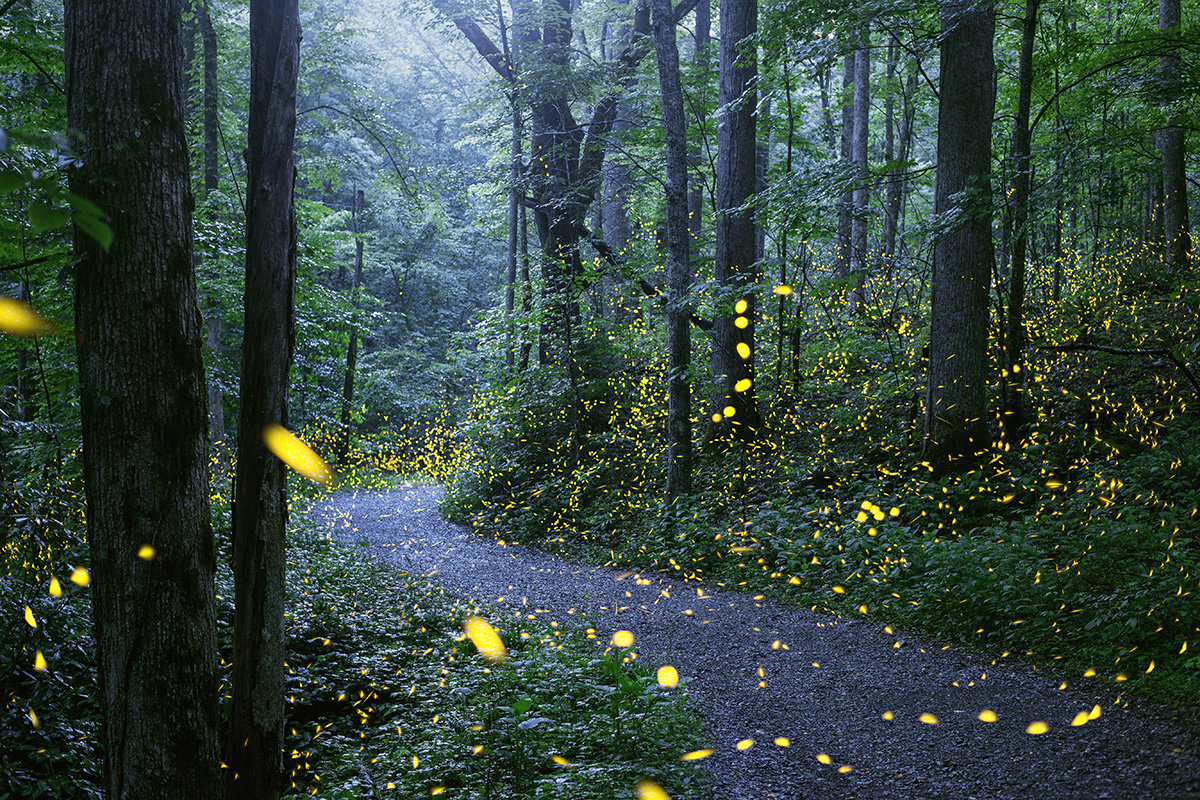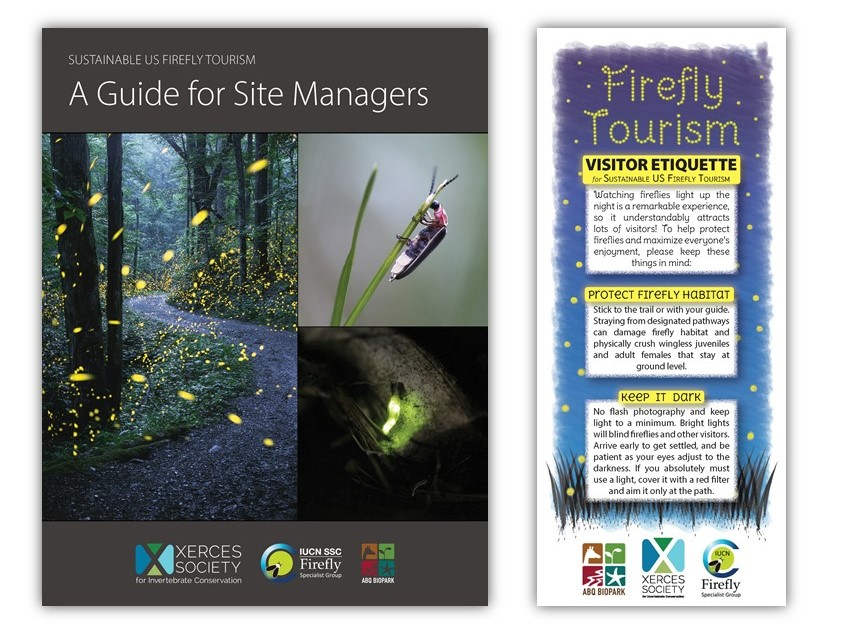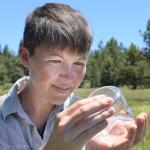Firefly tourism is on the rise in the United States. Of the more than 150 species of fireflies that occur in the US, at least five species—including the synchronous fireflies Photinus carolinus and Photuris frontalis—are of growing tourism interest.
Synchronous fireflies, whose males synchronize their flashes to light up in unison, are a relatively recently reported phenomenon in the US. In the early 1990s, Lynn Faust (now a renowned firefly expert and author of Fireflies, Glow-worms, and Lightning Bugs: Identification and Natural History of the Fireflies of the Eastern and Central United States and Canada) reported synchronous fireflies in Elkmont, Tennessee. An article she’d read had stated synchronous fireflies were restricted to the eastern hemisphere, but that didn’t make sense to her: she had been witnessing such a spectacle at her family’s cabin for years.

Synchronous fireflies line a path through Great Smoky Mountains National Park (Photo: Radim Schreiber, fireflyexperience.org).
Glow Bugs with Fan Clubs
Today, she’s not the only one to witness this light show. The fireflies at Elkmont (located in Great Smoky Mountains National Park) have become so popular that the park has initiated an annual lottery to mitigate some of the pressures of so many people hoping to see this incredible light show.
Now that the word is out and more people are aware of synchronous fireflies, the discoveries are increasing. Synchronous fireflies have been documented in multiple places throughout the eastern US, and it’s not just Photinus carolinus, either. Just a state away in Congaree National Park, SC, another synchronous species known as the snappy sync (Photuris frontalis) also draws large numbers of visitors in May. They too have adopted a lottery system, which just closed for the year. Other firefly species, such as the ethereal blue ghost fireflies (Phausis reticulata), have their own burgeoning fan clubs as well.
While all this excitement about fireflies and the resulting tourism boom can benefit local economies and help more people to experience the wonder of nature, it also presents challenges. Firefly tourism inevitably leads to greater numbers of visitors, which can result in habitat degradation, increased light pollution, physical crushing of larvae and adult females, and other threats if not managed appropriately. This is true of firefly tourism around the world. While a young industry in the United States, this type of tourism has been around for decades in places like Malaysia, Taiwan, and Japan. The many risks (and rewards) of firefly tourism were highlighted in an article by Lewis et al. (2021) titled Firefly tourism: Advancing a global phenomenon toward a brighter future, which also provided a roadmap for sustainable tourism across the world.
New Guidelines for Sustainable Firefly Tourism
Using this paper as a foundation for change, Xerces and partners (including several of the article’s authors) brought together a consortium of site managers, tour operators, event planners, and firefly researchers for a Firefly Tourism Charrette to discuss the challenges associated with firefly tourism, identify practical solutions, and draft a set of guidelines that could be used to promote sustainable firefly tourism in the US. The results of these efforts are a set of guidelines for site managers and an etiquette guide for visitors. The guidelines are intended to help site managers understand the basic needs of fireflies and identify ways to protect fireflies and their habitats while also providing educational and viewing opportunities for visitors, while the visitors guide provides tips for enjoying fireflies in a way that protects them and their habitats.

The consortium also led to the creation of a new group, the US Firefly Tourism Luminary Council (USTFLC), which is composed of volunteers from a variety of public and private, large and small firefly tourism providers. The main goal of the USTFLC is to disseminate informational resources and provide support to agencies and individuals providing tours and educational programs about fireflies in the United States. Whether you’re a long-standing tourism site or just starting to think about opening up to the public, the USTFLC is a great place to connect with the larger sustainable firefly tourism industry.
If you’re planning a visit to one of these tourism sites this summer, take a moment to look over the etiquette guidelines so you know how to enjoy the fireflies while minimizing risks to them and their habitats. And keep in mind that there are many places to enjoy fireflies, not just the famous national parks mentioned here. With so many species described (172 and counting) from every state except Hawaii, there are ample opportunities to take in the show. If you need some inspiration for other places to look, check out the map on Xerces’ website. And remember that sometimes the best show is simply the one happening right where you live—you don’t necessarily need to travel to appreciate the magic of a firefly’s light.
Learn More
Site managers guidelines: https://xerces.org/publications/guidelines/sustainable-us-firefly-tourism
Visitors etiquette guidelines (available in English, Spanish, French, and Chinese): https://xerces.org/publications/brochures/firefly-tourism
Read more about synchronous fireflies and some of the researchers and land managers working to protect them: https://www.atlasobscura.com/articles/synchronous-fireflies-appalachia
Didn’t get a lottery ticket for Great Smoky Mountains this year? Live vicariously through this article: https://www.washingtonpost.com/magazine/2021/09/07/great-smoky-mountains-fireflies-have-become-source-tourism-solace/
If you’re interested in finding a firefly tourism site beyond Great Smoky Mountains NP or Congaree NP, check out the map on our website.




